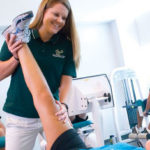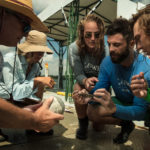“CSI: UWF” – field school teaches students how to research bones
Transforming the campus into a mock scene straight out of the hit television show "CSI: Crime Scene Investigation," the University of West Florida Department of Anthropology will offer a unique, hands-on course this summer. The Forensic Anthropology Field School, a course that teaches students how to successfully and efficiently find and handle skeletal remains, will be held May 11 through June 12.
Transforming the campus into a mock scene straight out of the hit television show “CSI: Crime Scene Investigation,” the University of West Florida Department of Anthropology will offer a unique, hands-on course this summer. The Forensic Anthropology Field School, a course that teaches students how to successfully and efficiently find and handle skeletal remains, will be held May 11 through June 12.
“Our field school focuses on field techniques for discovery, documentation and recovery of human skeletal remains,” said Joanne Curtin, associate professor of Anthropology. “Students learn proper search, mapping and excavation techniques. They also learn field photography, reporting and presentation skills.”
As part of the field school, two study skeletons have been buried on the UWF campus. The students were provided with a mock scenario in which someone killed and buried two people in the woods at UWF. The suspect confessed to the murders and burying the bodies, but cannot recall exactly where the bodies were buried. The forensic anthropology students are tasked with locating, mapping, photographing, excavating and reporting on the skeletal remains.
“The course gives students hands-on experience practicing a variety of skills essential to forensic anthropology,” said Curtin. “UWF is one of a few institutions in the United States to offer a field school of this nature.”
In addition to the on-campus exercise, students in the course will also have the opportunity to conduct research at St. Michael’s Cemetery in downtown Pensacola. The students will investigate and conduct test excavations of a suspected mass grave in the cemetery. UWF archaeologists have identified a few subsurface anomalies at the cemetery that they believe may be connected to the yellow fever plague that swept through Pensacola during the 19th century. Although no one has confirmed with certainty on what may have happened, Margo Stringfield, researcher with the UWF Archeological Institute, has a theory.
“Margo (Stringfield) suspects that when the epidemic swept through Pensacola, the residents may have made a mass grave and buried all of the victims in one place.” said Curtin. “The students will have the opportunity to work in the cemetery and assist in finding out if the anomalies are indeed part of a mass grave.”
The UWF Anthropology Field School is open to all majors, but is especially recommended for anthropology majors specializing in biological anthropology. Prerequisites for the course include “Biological Anthropology,” “Principles of Archaeology” and “Human Osteology” with a grade of “C” or better.
For more information about the Anthropology Field Schools at UWF, visit uwf.edu/anthropology/schools/. To learn more about St. Michael’s Cemetery, visit stmichaelscemetery.org/.
Written by Josh Lyons, University Marketing Communications


